1 Effective Strategies for Higher Education Marketing in a Digital Age
Contents
- 1 1 Effective Strategies for Higher Education Marketing in a Digital Age
- 2 2 The Role of Social Media in College Recruitment Efforts
- 2.1 Expanding Audience Reach
- 2.2 Encouraging Engagement
- 2.3 Leveraging Visual Content
- 2.4 Targeting Specific Demographics
- 2.5 Utilizing Analytics for Optimization
- 2.6 Partnering with Influencers
- 2.7 Maximizing Impact with Social Media Advertising
- 2.8 Ensuring Consistency with a Content Calendar
- 2.9 The Future of Social Media in Recruitment
- 3 3 Understanding the Needs of Today’s Prospective Students
- 4 4 Building a Compelling Brand Identity for Higher Education Institutions
- 5 5 Measuring the Success of Higher Education Marketing Campaigns
- 6 Summary
- 7 Author
The landscape of higher education marketing is rapidly evolving, propelled by digital advancements. Universities and colleges need to embrace innovative strategies that cater to the changing behavior of prospective students. With more people turning to online resources for education options, an effective digital strategy is key to attracting and retaining students.
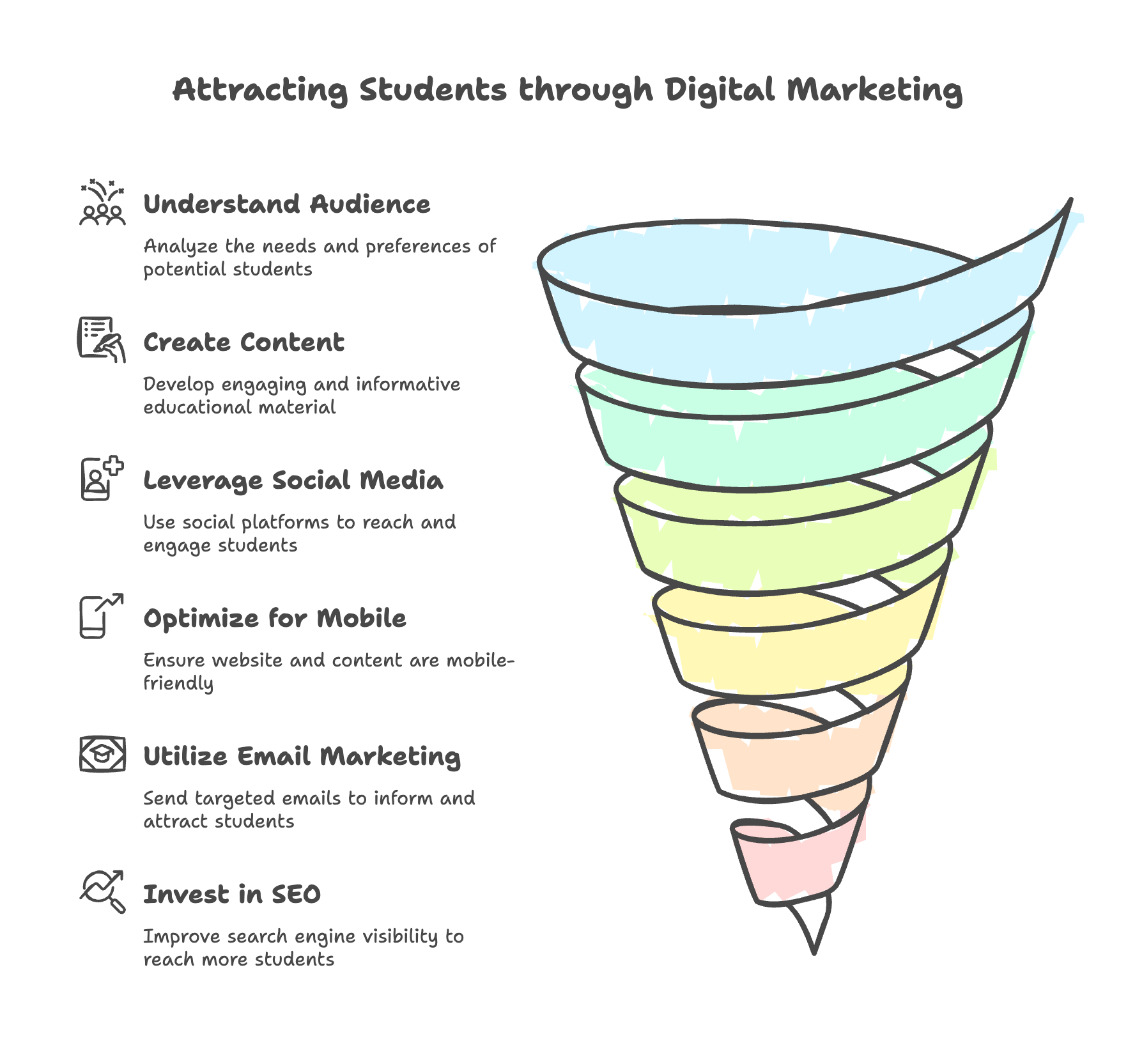
Understand Your Audience
To implement successful higher education marketing, begin by understanding your audience. Today’s students are not just looking for education; they seek experiences that align with their career goals and values. Conduct surveys and engage with potential students on social media to gather insights. Identify their pain points, interests, and motivations to tailor your message accordingly.
Create Compelling Content
Content is king in the digital marketing realm. Develop engaging content that speaks to your target audience. This could include:
- Blog Posts: Share informative articles on current trends, student life, and career advice.
- Videos: Use video tours, testimonials, and classroom experiences to give a snapshot of campus life.
- Webinars: Host live sessions on admission processes, programs offered, and career paths to engage prospective students directly.
This diverse mix will not only enhance engagement but also improve your search engine rankings.
Leverage Social Media
Social media platforms are no longer just for socializing; they are vital marketing tools. Utilize sites like Instagram, Facebook, and LinkedIn to connect with students and share your story. Here’s how to effectively use social media:
- Visual Storytelling: Share images and videos that showcase campus culture and student achievements.
- Real-Time Interaction: Engage with followers by responding to comments and messages promptly.
- Targeted Ads: Use Facebook and Instagram ads to focus on specific demographics, ensuring your message reaches the right people.
Using these approaches will foster a sense of community and increase your institution’s visibility.
Optimize for Mobile Users
With many students accessing information through their mobile devices, ensuring your website is mobile-friendly is crucial. A responsive design improves user experience and can reduce bounce rates. Here are some tips for optimizing your site:
- Fast Load Times: Ensure that your website loads quickly to keep visitors engaged.
- Clear Navigation: Design user-friendly menus so that visitors can easily find information.
- Touch-Friendly Buttons: Make sure buttons are easy to press on smaller screens to enhance navigation.
Utilize Email Marketing
Email marketing remains a powerful tool for higher education marketing. Building a solid email list allows you to communicate directly with potential students. Implement strategies such as:
- Personalization: Use recipients’ names and tailor content based on their interests.
- Regular Newsletters: Share updates about programs, events, and student stories.
- Promotional Offers: Highlight scholarships or early application discounts to encourage engagement.
Regularly analyzing the effectiveness of your emails can also help refine your approach.
Invest in SEO Strategies
Search engine optimization (SEO) is vital in helping prospective students find your institution online. Focus on the following aspects to improve your ranking:
- Keyword Research: Identify relevant keywords that potential students might use when searching for higher education institutions.
- On-Page Optimization: Use targeted keywords in your page titles, headings, and content, while ensuring it flows naturally.
- Backlinking: Encourage reputable sites to link back to your content. This boosts your credibility in search engines’ eyes.
By implementing these effective strategies in higher education marketing, your institution can stand out in a digital age. The goal is to foster real connections, providing prospective students with the insights and guidance they need in their educational journey. Building an engaging, informative, and accessible online presence will go a long way in attracting the right students to your institution.
2 The Role of Social Media in College Recruitment Efforts
Social media has become a powerful tool for engaging potential students and driving awareness around higher education institutions. For colleges and universities, utilizing social media effectively can significantly boost recruitment efforts. Understanding how to leverage these platforms is crucial for standing out in a competitive educational landscape.
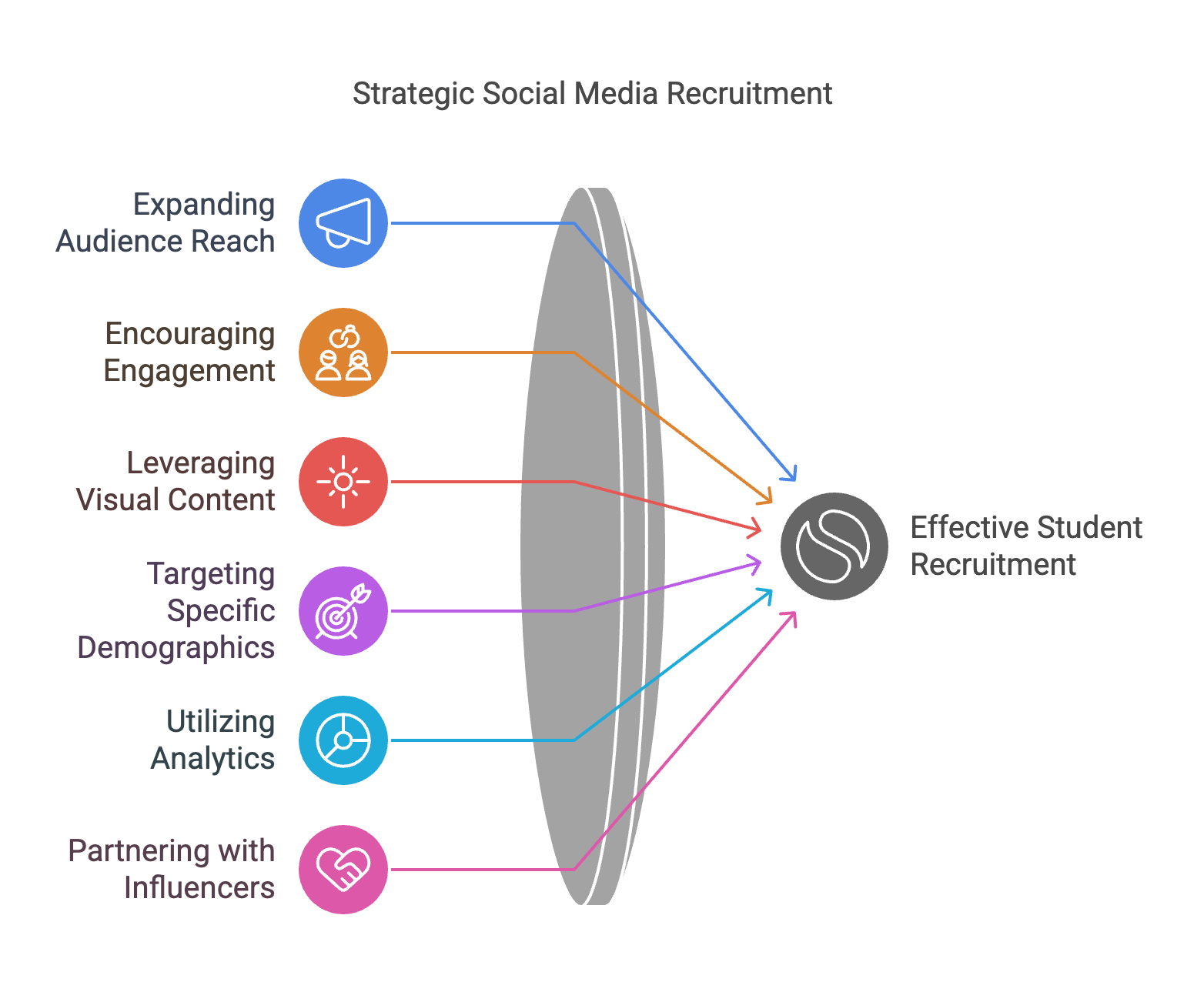
Expanding Audience Reach
One of the primary benefits of social media in college recruitment is its ability to reach a vast audience. With a single post, colleges can connect not only with prospective students but also with their families and friends, reaching hundreds or even thousands of people. Creating content that resonates emotionally is essential. Showcasing campus life, academic achievements, and student success stories fosters connections and builds trust.
Encouraging Engagement
Engagement is key to an effective social media strategy. Simply posting announcements isn’t enough. Colleges must interact with their audiences to create two-way communication. Strategies for boosting engagement include:
- Live Q&A Sessions: Use Instagram Live or Facebook Live to address student questions directly.
- Behind-the-Scenes Content: Provide glimpses into everyday campus life or special events.
- Student Takeovers: Let current students share their experiences and routines on your social media.
Leveraging Visual Content
Utilizing high-quality photos and videos is crucial for capturing attention and increasing engagement. Platforms like Instagram and TikTok excel in showcasing vibrant campus life, events, and facilities. Pairing compelling visuals with well-crafted captions creates strong, shareable narratives.
Targeting Specific Demographics
Social media platforms offer tools to target specific demographics based on age, location, and interests. Tailored messaging, such as ads for students interested in particular programs, ensures outreach efforts are focused and effective, resulting in meaningful engagement and higher conversion rates.
Utilizing Analytics for Optimization
Analytics are invaluable for refining social media strategies. By monitoring engagement metrics like likes, shares, comments, and click-through rates, colleges can identify what resonates with their audience. Adjusting strategies based on this data ensures continuous improvement in engagement and recruitment outcomes.
Partnering with Influencers
Collaborations with influencers, including alumni or personalities with significant followings, can enhance visibility. Authentic endorsements through guest posts, social media challenges, or other collaborations expand reach to new audiences, building credibility and interest.
Maximizing Impact with Social Media Advertising
Paid advertising on social media platforms is a powerful way to reach prospective students. Customizable targeted ads highlighting key aspects of the college, such as academic success rates or unique programs, draw interest. Including strong calls to action encourages viewers to learn more or visit the institution’s website.
Ensuring Consistency with a Content Calendar
Consistency and creativity are essential for effective social media use. Developing a content calendar helps maintain an active and cohesive presence by planning content like events, student highlights, and updates in advance.
The Future of Social Media in Recruitment
Social media offers colleges a platform to tell their stories, connect with diverse audiences, and interact directly with potential students. A well-rounded social media strategy enables institutions to attract and retain prospective students effectively. As higher education marketing evolves, adaptability within social platforms will remain critical for staying ahead and leveraging this dynamic tool to its fullest potential.
3 Understanding the Needs of Today’s Prospective Students
Understanding the needs of today’s prospective students is crucial for institutions aiming to thrive in a competitive higher education landscape. As the educational environment continues to evolve, so do the expectations and preferences of students. Whether you are part of a marketing team or an academic administrator, being attuned to these needs can enhance recruitment strategies, improve enrollment rates, and foster student satisfaction.
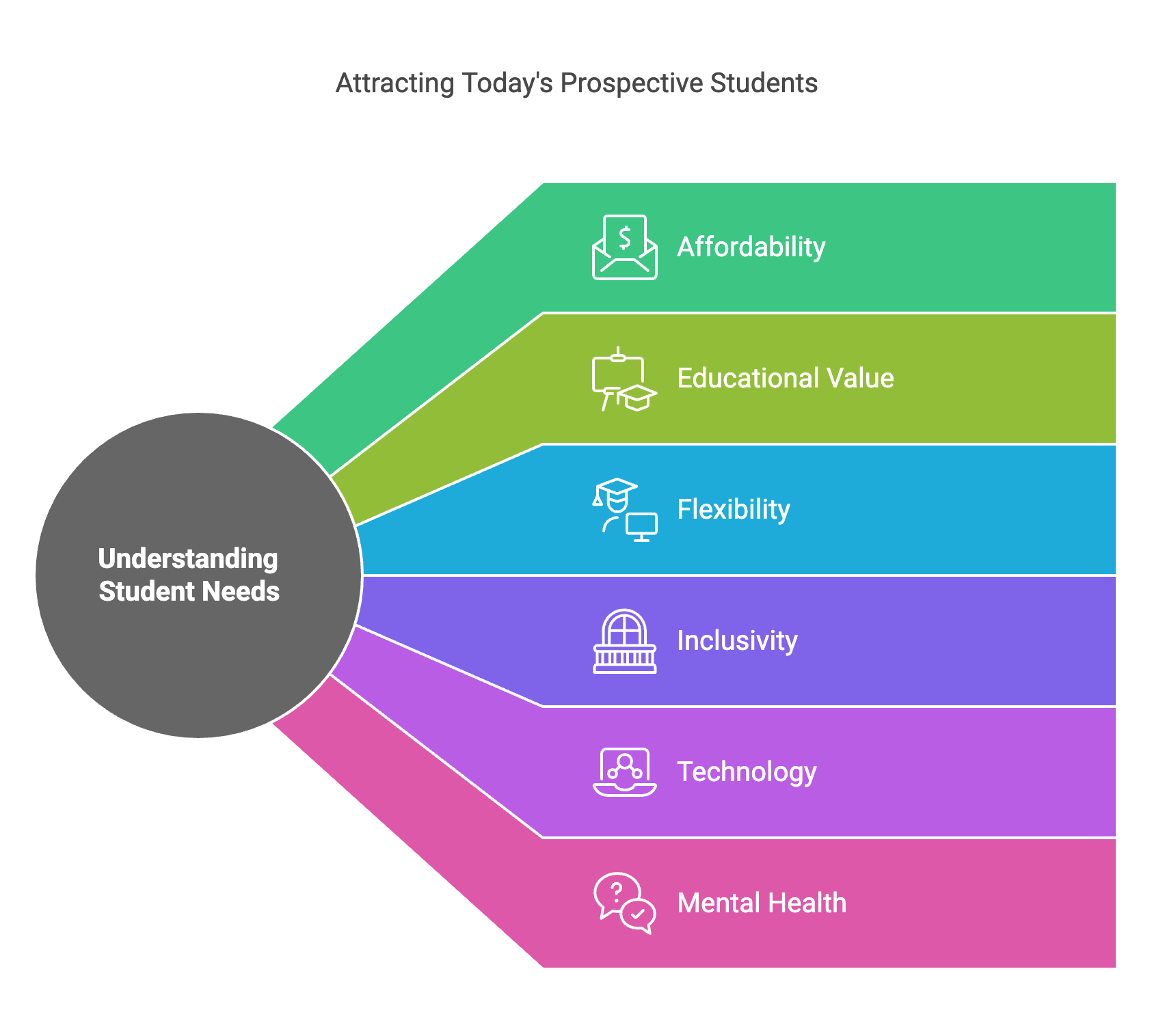
Addressing Affordability
Affordability is a pressing issue for many students as tuition costs continue to rise. Prospective students increasingly seek transparent information about tuition, financial aid options, and scholarships. Institutions can emphasize affordability through initiatives such as:
- Detailed tuition breakdowns
- Financial aid workshops
- Prominently displayed scholarship information
Emphasizing Educational Value
Today’s students value programs that deliver tangible outcomes, such as career advancement opportunities. Institutions should highlight:
- Job placement statistics
- Partnerships with businesses for internships
- Networking events and career fairs
Offering Flexibility
Modern students often juggle multiple responsibilities and prefer flexible learning options. Institutions can cater to these needs by offering:
- Flexible scheduling
- Hybrid learning options
- Asynchronous classes
Promoting Inclusivity and Cultural Relevance
A culturally relevant and inclusive environment is crucial for today’s prospective students. Institutions should showcase:
- Student organizations celebrating different cultures
- Support services for underrepresented groups
- Campus events promoting inclusivity
Leveraging Technology in Education
Technology integration is a major factor in attracting prospective students. Institutions should highlight their digital advancements, such as:
- State-of-the-art learning management systems
- Access to online resources and libraries
- Innovative educational tools
Prioritizing Mental Health Resources
Mental health is increasingly important to prospective students. Institutions should emphasize their commitment to student well-being by showcasing:
- Counseling services and workshops
- Peer support networks
- Health and wellness activities
Building a Sense of Community
A strong sense of belonging attracts prospective students. Institutions can foster this by:
- Engaging on social media
- Hosting campus tours and open house events
- Providing opportunities for prospective students to connect with current students, faculty, and administrators
Ensuring Effective Communication
Clear and consistent communication is vital in reaching tech-savvy prospective students. Institutions should adopt a multi-channel approach by:
- Regularly updating websites and social media profiles
- Sharing relevant and engaging content
- Utilizing email marketing campaigns to keep students informed and connected
By understanding these needs and preferences, educational institutions can improve their higher education marketing strategies. Focusing on affordability, educational value, flexibility, inclusivity, technology, mental health support, community building, and effective communication will resonate with today’s prospective students. In doing so, institutions can attract and retain a diverse range of candidates, enhancing their overall educational experience.
4 Building a Compelling Brand Identity for Higher Education Institutions
In an era where choices abound, developing a strong brand identity for higher education institutions is more crucial than ever. A compelling brand identity not only attracts prospective students but also fosters loyalty among current students and alumni. Building this identity involves a deep understanding of the institution’s values, mission, and the demographic it serves.
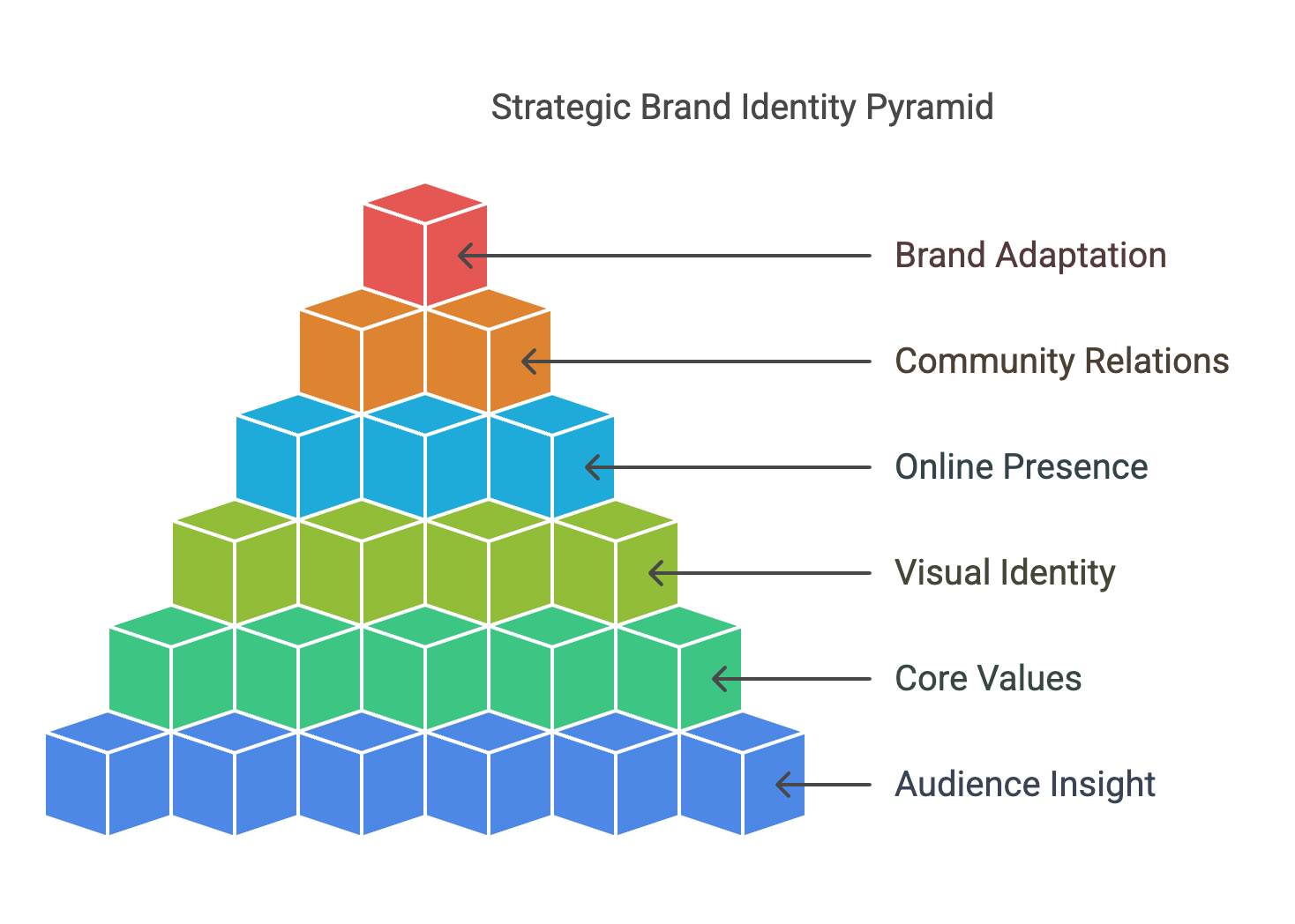
Understanding Your Audience
To create a brand that resonates, you must first understand your audience. You should consider:
- Demographics: Age, location, and background play significant roles in shaping preferences.
- Needs: What are the students looking for in a higher education experience? Job readiness, faculty expertise, or campus culture?
- Expectations: What do they expect from their chosen institution in terms of support, engagement, and community?
Gather this information through surveys, focus groups, or social media engagement. The insights gained will provide a solid foundation for your brand identity.
Defining Your Core Values
Once you understand your audience, the next step is defining the core values that set your institution apart. Your brand identity should reflect these values clearly. Ask yourself:
- What is our mission?
- What unique programs or opportunities do we offer?
- How do we want to be perceived by students, parents, and the community?
Focus on the unique aspects that differentiate your institution from others in the market. This could be innovative teaching methods, cutting-edge facilities, or a commitment to diversity and inclusion.
Crafting a Unique Visual Identity
Your visual identity is the face of your brand. This includes everything from your logo and color scheme to the typography used in marketing materials. Keep the following in mind:
- Logo: Ensure it is recognizable and reflects your institution’s mission.
- Color Scheme: Choose colors that evoke emotions you want associated with your brand.
- Typography: Select fonts that are easy to read and fit your institution’s personality.
Consistency is key. All materials, from brochures to websites, should align with this visual identity. This consistency helps reinforce brand recognition and trust.
Developing a Strong Online Presence
A robust online presence is non-negotiable in today’s digital age. This involves:
- Website: Your website should be user-friendly, informative, and reflective of your brand. Use engaging visuals and clear calls to action (CTAs).
- Social Media: Engage with prospects and current students on platforms they frequent. Share stories, successes, and community events. Authenticity matters.
- Content Marketing: Create valuable content that addresses the needs of your audience. This could include blog posts, podcasts, or webinars about topics important to students.
Utilizing SEO strategies enhances your visibility in search engines, making it easier for prospective students to find you.
Building Relationships and Community
A strong brand identity is not just about how you position yourself externally. It involves building relationships within your community. Consider ways to:
- Engage Alumni: Keep alumni involved through newsletters and events. They can become your brand ambassadors.
- Foster Current Student Engagement: Create platforms for students to share their experiences, ideas, and feedback. This shows you value their voices.
- Connect with Local Businesses: Collaborate on initiatives that benefit both the institution and the community.
These relationships can lead to organic growth as satisfied students and alumni share their experiences and attract new prospects.
Measuring and Adapting Your Brand Strategy
It’s crucial to measure the effectiveness of your branding strategies. Use tools such as surveys and analytics to gauge how your brand is perceived. Analyze:
- Traffic to your website
- Engagement on social media platforms
- Enrollment numbers against your campaign efforts
Knowing how your audience responds will enable you to adapt your strategies and improve your brand identity over time. In the fast-paced world of higher education, being flexible can make all the difference.
Clearly, building a compelling brand identity in higher education takes time and requires thoughtful strategies. By understanding your audience, defining your values, creating a unique visual identity, enhancing your online presence, fostering community, and measuring your efforts, you can craft a brand that not only resonates with potential students but stands the test of time.
5 Measuring the Success of Higher Education Marketing Campaigns
In today’s digital landscape, measuring the success of higher education marketing campaigns is more critical than ever. Institutions must understand how effective their strategies are to refine their approach and achieve their enrollment goals. Successful marketing campaigns not only attract prospective students but also build long-lasting relationships that can enhance an institution’s reputation. Here’s how to assess the effectiveness of these campaigns.
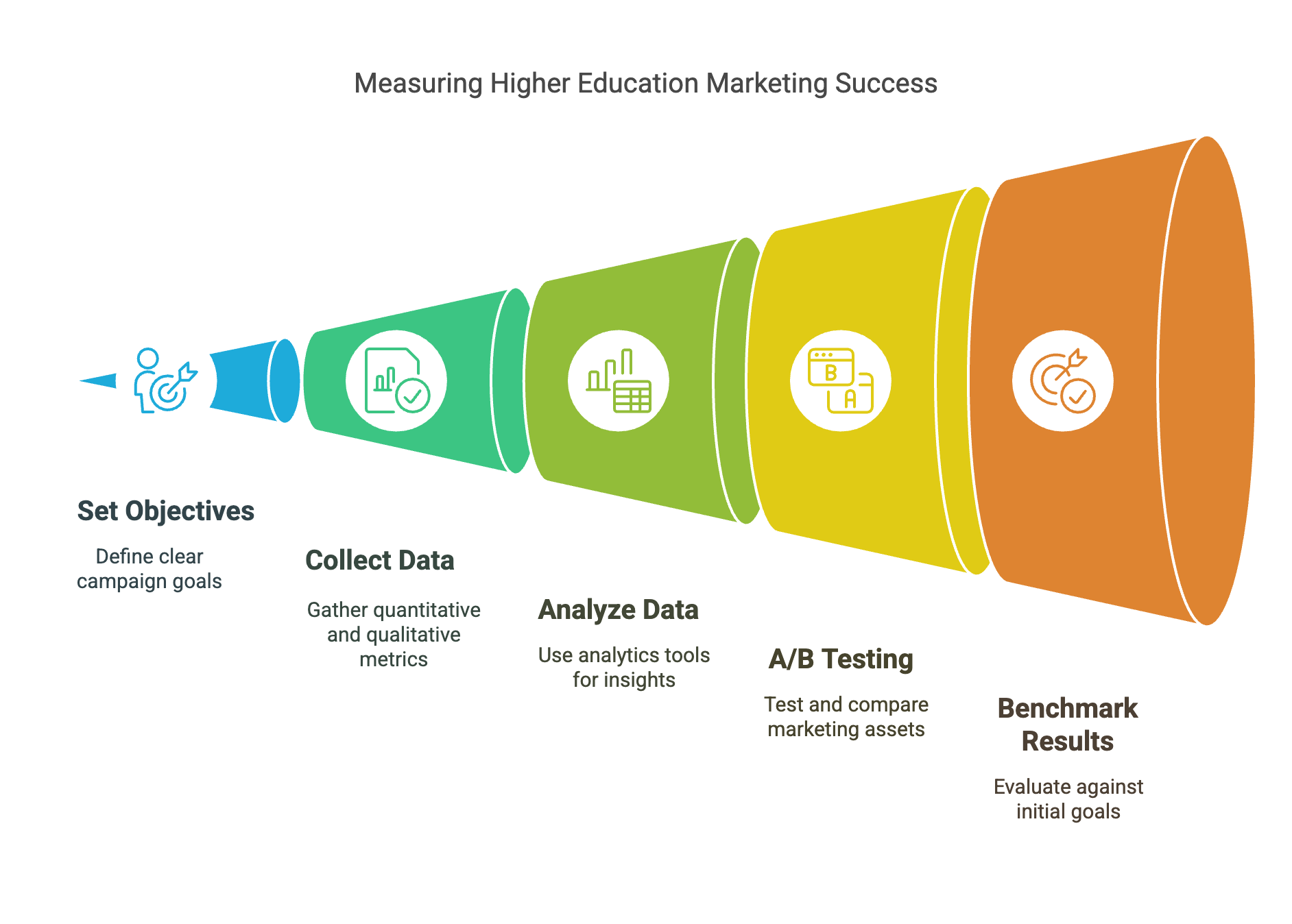
Quantitative Metrics
One of the primary methods to measure success is through quantitative metrics. These figures provide statistical evidence that can help institutions gauge their marketing efforts. Key metrics include:
- Website Traffic: Monitoring the number of visitors to the institution’s website can indicate the effectiveness of online ads and SEO strategies.
- Conversion Rates: This measure indicates how many visitors take a desired action, such as filling out an inquiry form or applying for admission.
- Social Media Engagement: Likes, shares, and comments on social media posts help assess how well the content resonates with prospective students.
- Email Open and Click Rates: These metrics measure the effectiveness of email campaigns and indicate whether the content is relevant to your audience.
Qualitative Metrics
While numbers tell part of the story, qualitative metrics provide deeper insights into the effectiveness of a marketing campaign. Their subjective nature allows institutions to gather feedback and understand students’ perceptions, including:
- Surveys and Focus Groups: Conducting surveys among prospective students can uncover their needs, preferences, and opinions on marketing campaigns.
- Brand Awareness: Evaluating how many prospective students recognize your institution can shed light on the broader impact of your marketing efforts.
- Content Feedback: Understanding how your audience views the quality and relevance of your content allows you to modify your strategies accordingly.
Analytics Tools
Utilizing analytics tools can greatly enhance your ability to measure campaign success. These tools provide comprehensive data that allow for quick analysis and adjustments. Some recommended analytics tools for higher education marketing include:
- Google Analytics: This powerful platform tracks website traffic and user behavior. It helps institutions understand which marketing channels are driving the most traffic.
- Social Media Analytics: Each social media platform offers native analytics features that allow you to monitor engagement metrics and audience demographics.
- Email Marketing Software: Services like Mailchimp or Constant Contact offer analytics that tracks open rates, click rates, and unsubscribe rates, providing insights into email campaign effectiveness.
A/B Testing
A/B testing is another valuable technique to measure the success of marketing campaigns. By comparing two versions of a marketing asset, such as email layouts or ad copy, institutions can identify which version performs better. Here are several areas to consider when conducting A/B tests:
- Email Subject Lines: Experimenting with different approaches can help discover what encourages readers to open your emails.
- Landing Pages: Testing various designs or content on your landing page can reveal what leads to higher conversion rates.
- Ad Copy: Assessing different messaging in your online ads helps determine what catches the audience’s attention and drives them to take action.
Benchmarking Against Goals
Ultimately, one of the best ways to measure the success of higher education marketing campaigns is by benchmarking their results against initial goals. Institutions should establish clear, measurable objectives before launching campaigns. These may include:
- Increasing applications by a certain percentage
- Boosting enrollment numbers for a specific program
- Improving alumni engagement and community support
By evaluating campaign performance against these goals, institutions can ascertain where they’ve succeeded and where adjustments are needed.
Assessing the success of higher education marketing campaigns requires both quantitative and qualitative metrics. With the right tools and strategies, institutions can fine-tune their marketing efforts, boost engagement, and ultimately drive enrollment. By focusing on measurable outcomes and pursuing constant improvement, educational institutions can thrive in today’s ever-evolving higher education landscape.
Summary
As higher education continues to evolve in the digital age, it is crucial for institutions to adopt effective marketing strategies that truly connect with prospective students. Leveraging social media effectively can enhance college recruitment efforts, allowing institutions to engage with a wider audience and build meaningful relationships. Understanding the needs of today’s students—who prioritize authentic communication and personalized experiences—has never been more important.
Building a compelling brand identity is also key in differentiating your institution from competitors. When prospective students resonate with your brand, they are more likely to envision themselves as part of your academic community. Additionally, regularly measuring the success of your marketing campaigns enables institutions to identify what works and refine their strategies for better results.
By focusing on these aspects, higher education marketing can create a strong foundation for attracting and retaining students. This blend of strategy, communication, and brand identity not only enhances recruitment efforts but also fosters loyalty and community among enrolled students. As you continue to explore and implement these advanced strategies, remember that the ultimate goal is to create value for prospective students, guiding them on their educational journey and setting them up for future success. Embrace innovation and adapt to the changing landscape, and your institution will thrive in this competitive environment.
